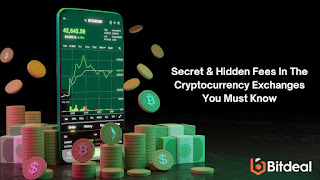Uncovering the Hidden Fees of Cryptocurrency Exchanges: What You Need to Know
In the dynamic world of cryptocurrency trading, where fortunes are made and lost in the blink of an eye, understanding the financial landscape is crucial. It's important to peel back the layers and explore the hidden fees that often lurk beneath the surface of cryptocurrency exchanges for traders and cryptocurrency exchange development for entrepreneurs. In this article, we'll delve into the world of hidden fees, shedding light on what you need to know to navigate this intricate terrain.
The Allure of Cryptocurrency Exchanges
Cryptocurrency exchanges serve as the gateway to the exhilarating realm of digital asset trading. These platforms enable users to buy, sell, and trade a wide array of cryptocurrencies, offering opportunities for profit and diversification. The transparency and decentralized nature of blockchain technology have contributed to the allure of cryptocurrencies, fostering a global community of traders and investors.
Unmasking Hidden Fees
While cryptocurrency exchange development boasts of low transaction fees and high liquidity, hidden fees can significantly impact your overall trading experience. These concealed charges are often overlooked or not adequately disclosed, catching traders off guard and affecting their profitability.
1. Trading Fees Trading fees are perhaps the most common hidden charges on cryptocurrency exchanges. These fees are associated with executing trades and can be categorized into two main types: maker fees and taker fees.
Maker Fees: When you place an order that doesn't get immediately matched with an existing order on the order book, you're considered a "maker." Maker fees are typically lower because you're adding liquidity to the market.
Taker Fees: If your order is matched with an existing order on the order book, you're a "taker." Taker fees are usually higher as you're taking liquidity from the market.
These fees might appear small for individual trades, but they can add up quickly, especially for high-frequency traders.
2. Withdrawal and Deposit Fees
Deposit and withdrawal fees are often overlooked but can be substantial, particularly when dealing with small transactions. Exchanges can impose fees on both depositing and withdrawing funds, which can erode your profits, especially if you're moving funds frequently.
3. Inactivity Fees
Some exchanges have inactivity fees, which are charges levied on accounts that remain dormant for an extended period. This is a way for exchanges to encourage active trading but can catch users unaware if they're not aware of the policy.
4. Listing Fees for Tokens
For traders and investors, the variety of tokens available on an exchange is a key consideration. However, some exchanges charge projects to list their tokens, and these fees can be substantial. While this might not directly impact individual traders, it can influence the diversity and availability of tokens on a platform.
5. SpreadThe spread is the difference between the buying price (ask) and the selling price (bid) of an asset. While not a fee in the traditional sense, a wider spread can affect the price you pay when executing trades, indirectly impacting your costs.
Types of Cryptocurrency Exchanges and Their Hidden Fees
1. Centralized Exchanges (CEX)
Centralized exchanges are the most common type of crypto trading platform. Centralized exchange development offers high liquidity, ease of use, and a wide variety of cryptocurrencies. However, they come with their own set of hidden fees:
Trading Fees: These are the most apparent fees on exchanges. They can be divided into maker fees (for adding liquidity to the order book) and taker fees (for executing trades immediately). The actual fee structure can vary widely between exchanges and can significantly impact your trading costs.
Deposit and Withdrawal Fees: Some centralized exchanges impose fees on both depositing funds into your account and withdrawing funds to your wallet. These fees might seem trivial per transaction, but they can accumulate over time.
Inactivity Fees: To encourage active trading, certain exchanges charge inactivity fees if your account remains dormant for a specific period.
2. Decentralized Exchanges (DEX)
Decentralized exchanges, in contrast, promise greater user control and privacy. However, they are not fee-free:
Network Fees: DEXs often operate on blockchain networks, and every transaction you make requires network fees (gas fees). These fees can fluctuate based on network congestion.
Swap Fees: While DEXs eliminate the need for traditional trading fees, they charge swap fees for converting one cryptocurrency into another. These fees contribute to the liquidity of the platform.
Hybrid Exchanges
Hybrid exchanges aim to combine the best of both worlds – the speed and liquidity of centralized exchanges with the privacy and control of decentralized exchanges. Their fees can be a mix of those found on CEXs and DEXs.
Navigating Hidden Fees
Armed with the knowledge of these potential hidden fees, there are strategies you can adopt to mitigate their impact:
Thorough Research: Carefully research different exchanges and their fee structures before committing to one. Compare trading fees, withdrawal and deposit fees, and any other hidden charges.
Reading the Fine Print: Scrutinize the terms and conditions of an exchange to understand their fee policies. Look for any mentions of inactivity fees or other less obvious charges.
Consider the Total Cost: Evaluate exchanges based on not just the trading fees, but also the hidden costs that might be associated with using the platform.
Consolidate Transactions: To minimize withdrawal fees, consider consolidating your transactions. Instead of making frequent small withdrawals, batch your transactions to reduce the impact of withdrawal fees.
Conclusion
As you venture into the exciting world of cryptocurrency trading or cryptocurrency exchange development, understanding the hidden fees associated with exchanges is essential for making informed decisions. While the promise of profits is undoubtedly captivating, the impact of hidden fees can't be ignored. By researching exchanges, reading the fine print, and staying vigilant, you can navigate this complex landscape with greater confidence, ultimately optimizing your trading experience. Remember, in the world of cryptocurrency, knowledge is power, and being aware of hidden fees is a significant step toward achieving success.




Comments
Post a Comment